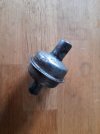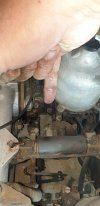Objective
Member
Addressing our 1971 TC 2000 crankcase breather 'system', all joints were loose and some rubber piping has turned to mush. What I found was a flame trap (photo) that seems completely blocked (I cant blow through it, let alone see daylight through it!) and a completely blocked carburettor inlet (photo) - can't tell yet whether the blockage is perished rubber or crud from the crankcase. The flame trap isn't freeing up with petrol (not so much 'flushing' as 'bathing') and clearly the whole system needs replacing.
I'm tempted to forget negative crankcase pressure for a time while I rebuild the carbs . . . sealing the carb inlets and directing the crankcase vent via a filtered capture tank. I'll rebuild and rebalance the carbs and run up some kilometres to see if anything gathers in the capture tank and reassess how the engine's running goes.
Has anyone got any comments on this plan, which I recognise isn't keeping everything 'original'. Is the pressure generated by the carb feed really significant, since its not been contributing for some time!
I'm tempted to forget negative crankcase pressure for a time while I rebuild the carbs . . . sealing the carb inlets and directing the crankcase vent via a filtered capture tank. I'll rebuild and rebalance the carbs and run up some kilometres to see if anything gathers in the capture tank and reassess how the engine's running goes.
Has anyone got any comments on this plan, which I recognise isn't keeping everything 'original'. Is the pressure generated by the carb feed really significant, since its not been contributing for some time!



